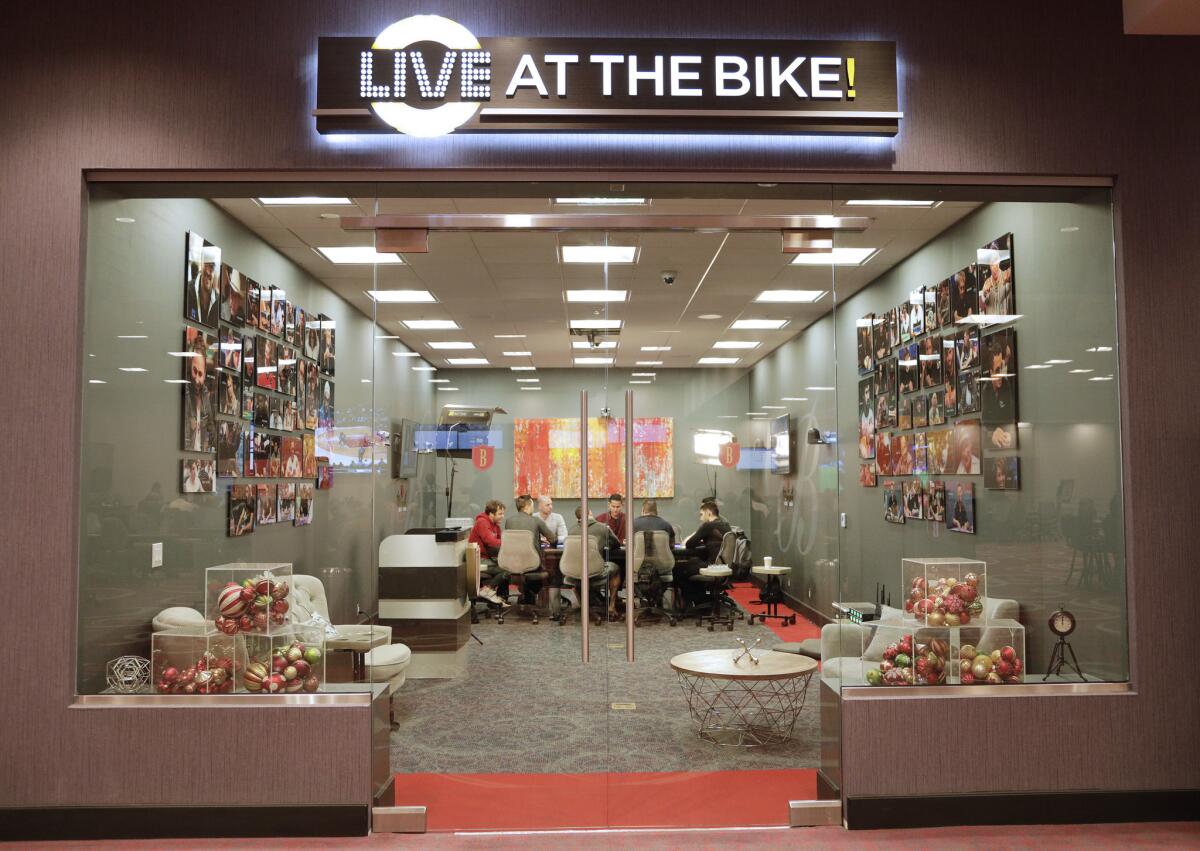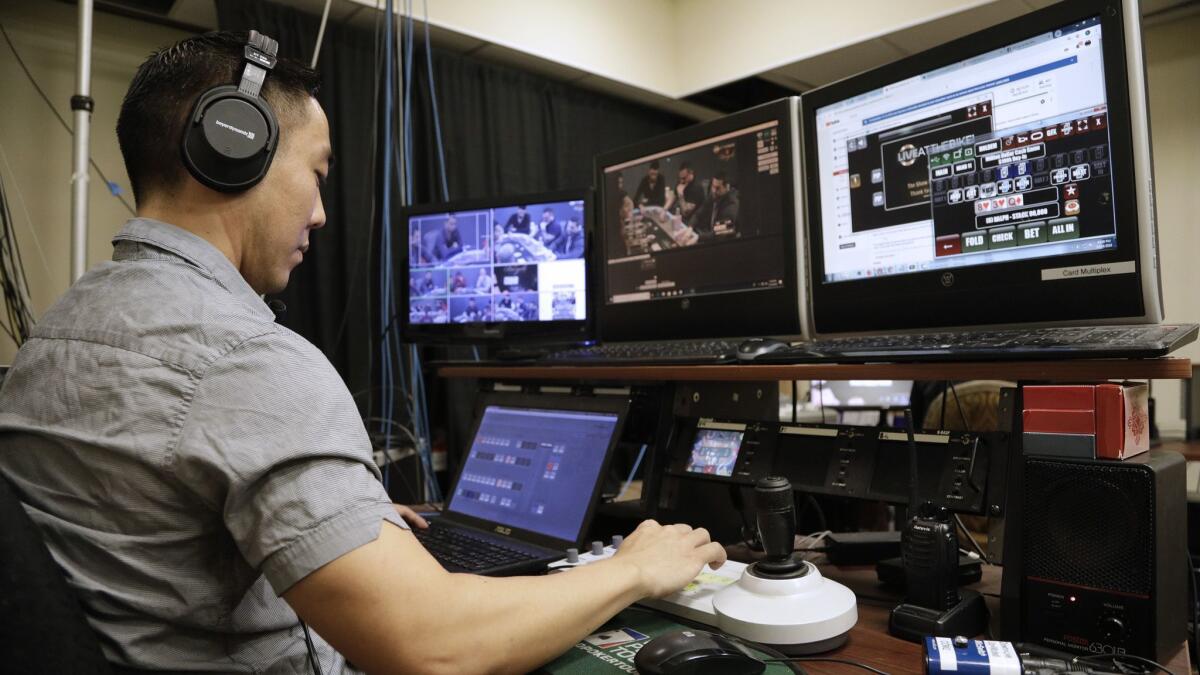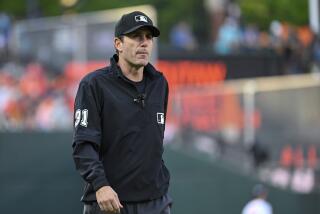Building a $1-million poker game for ‘Live at the Bike’

- Share via
One Friday this past December, behind the glass doors of a studio inside the Bicycle Hotel and Casino in Bell Gardens, a well-mannered but strategically disruptive professional gambler named Matt Berkey reached for a pouch beneath his seat at the poker table.
High-stakes players harbor a curious relationship with money. Those who excel at accumulating it often become inured to its significance. Berkey wore an aloof expression as he upended the bag. A rush of lavender splashed across the felt, 40 chips in all, each worth $5,000, a sudden six-figure infusion into a rarefied no-limit Texas hold-em game.
The table of seven already had more than $700,000 on board. The additional investment sparked an immediate reaction. A pro named Garrett Adelstein fished $100,000 in chips out of his own bag, raising his own stack to nearly a quarter-million dollars.
Inside a makeshift control room about 60 paces from the studio, Ryan Feldman’s feet tapped beneath a poker table that had been converted into a broadcast station. It had taken weeks of planning and seven hours of play, but with the extra $300,000, his vision for this night appeared before him on the monitor.
“Ladies and gentlemen,” Feldman told more than 8,000 viewers watching the streaming broadcast through YouTube, Twitch and Facebook, “we officially have $1 million on the table. Not something we’ve ever seen before on ‘Live at the Bike,’ or here at the Bicycle Casino.”
The game represented the culmination of a marathon of texting and cajoling from Feldman, the 33-year-old co-owner and producer of “Live at the Bike”. His task was sizable yet delicate: Persuade players to buy in for a minimum of $100,000 and play poker at stakes 20 times higher than the biggest game often spread at the casino.
The lineup needed to be juicy enough to entice risk-adverse professional players and collegial enough to bring in deep-pocketed amateurs. Feldman assembled the seven players at the table, some considered the best in the city, others flown in from Las Vegas: Adelstein, a man described on another show as “the kingpin” of high-stakes poker in Los Angeles; Berkey, the volatile pro from Las Vegas; Prahlad Friedman, a fixture of ESPN’s poker coverage in the 2000s; Art Papazyan, the reigning World Poker Tour player of the year; Nick Vertucci, an Orange County real estate investor who played often on the stream; Andy Tsai, another regular; and Ralph Wong, a former basketball analyst turned cryptocurrency investor.
The game had nearly collapsed earlier in the week, after three players dropped out and replacements were hard to find. Almost all the advertising for the show arose from word of mouth, and Feldman spent nearly two years trying to hustle advertising. The credibility of the brand depended on his ability to deliver. “I’d be screwed,” he said, “if I didn’t have a show.”
He felt satisfied in salvaging this lineup. Adelstein acknowledged the “thankless job” Feldman undertook. “All day, every day, someone’s mad at you about something,” Adelstein said. “He’s not getting rich off of building these games. He does it because he loves poker.”
After Adelstein and Berkey raised the stakes to $1 million, Feldman wanted to advertise the moment. He muted his microphone and rose from his chair. He walked to a black lockbox, where phones are stored to protect the integrity of the game.
Feldman grabbed his and marched to the door: “All right, I’m going to screenshot and tweet it out. I’ll be right back.”
::
Two weeks earlier, Feldman stood inside the control room with director Brian Arakaki and shared their idea for the “Million Dollar Cash Game.”
“People want to see big money,” Feldman said. “And if we market it that way, it’s something different, and it gets people excited.
Live at the Bike launched in 2005 while the initial wave of the poker boom was cresting. Interest spiked after ESPN broadcast the improbable, $2.5-million victory at the 2003 World Series of Poker by an amateur named Chris Moneymaker. With new technology capable of revealing hole cards to viewers, poker television shows mushroomed — from the World Poker Tour to “Celebrity Poker Showdown.”
The tournaments — played until one winner takes all — were made for television, with fans howling in the background, players hiding their eyes behind sunglasses and millions changing hands with the flip of a card. But they were also far removed from the average cash game at a casino, where players can buy back in if they lose their money, or walk away whenever.
The idea behind “Live at the Bike” was to offer a more realistic product, explained Eveliene Dullaart, the founder of Joker Gaming, the company which runs the stream.
“Playing poker in real life is different than what you see on TV,” Dullaart said. “It’s not all shoving all-in and whatnot. It’s a lot of grinding and regular work.”
About 900 subscribers pay at least $19.99 a month for access to the telecasts, Feldman said. But the majority of the eyeballs come from livestreams through YouTube and Twitch.

The casino does not own “Live At the Bike,” but the show helps coax viewers from their couch to the casino floor. As viewers flock to streaming services, poker has become more prevalent on the platform. PokerGo simulcasts with the World Series of Poker during the summer. PokerStars streams its major live events on YouTube, and “Poker Night in America” streams occasional cash games on Twitch. But “Live at the Bike” is the only poker show running five days a week, year-round, on YouTube.
Feldman grew up in the suburbs of Philadelphia, went to college at Temple University and joined ESPN as a researcher. He spent his down time at a nearby casino. After a couple years, he felt burned out with his job and drawn to the felt.
“I was just like, ‘You know what? I’m just going to leave, try to play poker, figure out what to do next,’” Feldman said. “And then this gig came up.”
Feldman often commentates, and occasionally plays in the games. But his primary responsibility is setting them up.
“One of the hardest things to do for a stream of poker is to get players to commit,” Dullaart said. “Because they’re poker players. They’ll say ‘yes,’ and they won’t show. It’s very hard to spread games for a show every night, and have an outcome that the viewers will love to see. And he has been able to do it since day one.”
As interest increased, Feldman lured well-known pros such as Phil Hellmuth, Mike Matusow and Antonio Esfandiari to the stream. The celebrities tangled with locals with names such as “Israeli Ron” and “Gil The Plumber.” Viewers became enamored with regulars like Adelstein and Tsai.
The highlight of the show was each Friday’s game, with players buying in for $5,000 or more. It developed into the show’s staple, with thousands watching online. Yet the realism soon reflected the game’s Darwinian tendency, Arakaki and Feldman explained.
“As the stakes get bigger, the player pool gets much, much smaller,” Arakaki said. “When people go bust — when the players who the pros come for go bust, or just run bad — it’s tough.”
By December, the group of regulars playing on Fridays had dwindled to about half a dozen. The producers knew they need a spectacle to shake things up, so they aimed for a moonshot goal: a $1-million table: 10 players to buy in for $100,000.
There was one hurdle.
“I’m just thinking,” Feldman said, “like, ‘who would actually play in it?’”
::
A poker game is like an ecosystem: In order to entice predators, you need prey. Otherwise, sharks will hunt elsewhere. Feldman believed that the formula for an appealing show required “big money and action and names.” All three are in diminishing supply. The glamour of poker has faded, the unpredictability of play has stabilized as pros become more technically proficient and the riches at stake have decreased.
The environment has gotten tougher for several reasons, players said. The banning of online poker in the United States in 2011 limited the money flowing into games. The emergence of new markets such as Macau redirected some players. The number of unregulated, private games played outside casinos has proliferated.
“Because the player pool is so small, and there’s such a low influx of outside money coming in, it’s difficult to find games that aren’t just the same routine five to 10 people,” Berkey said.
Feldman aimed to find players who could “juice it up a little bit,” he said. For the “Million Dollar Cash Game,” he cast a wide net, only to see targets slip through his grasp. A major tournament in Las Vegas that week complicated matters.
“I literally just hit like everybody in my Rolodex,” he said. “Even people I didn’t know, just asking other people for people’s numbers. Like who can we get?”
Adding to the tension, Feldman had advertised the “Million Dollar Cash Game” on Twitter nine days before the event. He had only four players committed, but opted for the “semi-bluff” — betting like he had the best hand, but knowing he needed to catch a card to make it so.
A lifeline emerged in the form of Berkey, a former college baseball player with a degree in computer science. Berkey had distinguished himself with his tolerance for perilous stakes, his flair for debonair fashion and his knack for audacity on the felt. He considered his style a gateway into lucrative situations.
“Yes, I’m a professional,” Berkey said. “But people are going to want me in games because I’m disruptive. And being able to implement that level of chaos, it’s the right kind of action.”
Berkey satisfied three requirements — his name carried weight in the poker world, he would bring plenty of money, and he would not be afraid to use it. At 36, he would be one of the older players in the lineup.
The eldest member of the group was Vertucci, a 52-year-old who operates a real estate academy in Santa Ana. He started playing on the show in 2017, thrilled by the competition and hungry to improve. He sensed at the outset that he was “the mark,” the fish sought by the sharks. But he felt he had sharpened his game through experience and study.
The stream was supposed to begin at noon but Vertucci and others got caught in traffic. As players straggled into the studio, Feldman cracked that he should have told everyone the game began two hours earlier. About 20 minutes past 12 p.m., Feldman offered some last-minute instructions to the group — turn the clip-on microphones off when using the bathroom, “absolutely” no phones at the table. Then he snapped a picture of the scene.
The seven players had bought in for a collective $750,000, a sizable sum but still short of $1 million.
Feldman left for the broadcast studio, crafting a message to the stream’s 11,000 Twitter followers:
“MILLION DOLLAR CASH GAME.
“Tune in now! We are live!!!”
::

About two hours into the session, Vertucci peeled the edges of his cards and saw a dream: the ace of hearts and the ace of clubs, pocket aces, the best possible starting hand, a combination that only occurs once every 221 hands. Staring at an initial bet of $800 from Berkey, Vertucci raised to $2,000. Berkey wielded a mediocre Jack-seven of spades. He called.
The early play had been tentative, but the game was heating up. Berkey was down nearly $37,000. Vertucci had dropped about $10,000. Berkey considered Vertucci a “competitive amateur.” Vertucci knew Berkey was “a wild man.”
The flop brought a whiff of danger, two nines and an eight. After Berkey checked, Vertucci bet $1,600, a decision he regretted. Berkey could have called, searching for a 10 to complete his straight draw. He opted for something more sinister, raising to $6,500. Vertucci stayed steely as he made the call, but the momentum of the hand had shifted toward Berkey.
Inside the booth, director Arakaki and videographer Patrick Curran sensed Berkey’s intentions. A little while earlier, Berkey had jammed all-in on the river against Adelstein. He held a full house, but Adelstein managed to fold three 10s. Now Berkey was preparing to make a similar play as a bluff. The dealer turned the six of diamonds, giving Berkey an open-ended straight draw, and he obliged with a $10,000 bet. Vertucci studied the board before dropping a pair of lavender chips into the middle.
At his monitor, Curran shook his head. “He has to just hold on down to the felt,” he said.
The river brought the king of clubs, a relatively inconsequential card. The first four had already caused Vertucci’s aces to shrivel in value. He could not beat pocket eights, pocket sixes or any combination featuring a nine. He also would lose to a straight from hands like 10-seven or seven-five, all of which were within Berkey’s range. And with all of those hands, Berkey would do exactly what he did next.
“All in,” Berkey said. Vertucci rolled his eyes, looked away from the table and swallowed. He glared at Berkey.
Down the hallway, Curran and Arakaki shouted into a void.
“If he folds this,” Curran said, “I’m going to start crying, probably.”
“Just call, man,” Arakaki said.
Curran edged a mouse over the graphic display, one option reading “CALL,” another marked “FOLD.” Vertucci clasped his hands and asked for a precise count of Berkey’s stack. The bet was $45,700.
One camera trained on Vertucci, who looked stricken. The other caught Berkey, who looked like he might be asleep.
When Adelstein started talking across the table, Vertucci asked for quiet. “Sorry, sorry,” Adelstein said, patting Vertucci on the back. The silence did not help.
Vertucci would admit later he had “no idea where Matt Berkey was in the hand.” He knew he might be losing. He knew Berkey might have nothing. He viewed his decision as a coin flip. After more than three minutes, Vertucci flung his cards into the middle.
In the booth, Curran moaned “Oh no!” and clicked the “FOLD” button.
::
About five hours into the broadcast, Feldman burst into the control room. He had been playing on the casino floor for most of the afternoon, sneaking glances at the broadcast on a big screen near the Bike’s bar.
“Man, that would have been so sick if Nick called with aces,” Feldman said to Arakaki and Curran. “That would have been awesome.”
After folding to Berkey’s bluff, Vertucci was down nearly $30,000. His hole steepened to more than $40,000. The tide started to turn for Vertucci after he won an $83,000 pot when his ace-high flush beat Adelstein’s three 10s. He chiseled his way back past even when he won a $13,000 pot off Berkey seven hours into the stream.
The comeback coincided with Feldman’s arrival, and a surge in spectators. Feldman settled into a plate of chicken wings, prosciutto and cucumbers. He checked the audience — there were 7,000, just shy of the stream’s record of 7,300 set the previous year.
The record was broken in the seventh hour. As Feldman announced that 7,400 viewers were following live, Berkey and Adelstein added that crucial $300,000 to the table. The total on the felt had reached $1 million after all.
Berkey and Adelstein spent the next few hours cracking heads in pursuit of it, as viewership passed 8,000.
“If we could have these two on every week,” Arakaki said, “it would be sick.”
Vertucci recovered from Berkey’s bluff to bank a $16,000 profit. Berkey dropped nearly $177,000, but awed Arakaki and Curran with his relentless aggression.
At 12:04 a.m., after 332 hands and more than 11 hours of play, Feldman signed off. He thanked the audience for taking part in the longest stream in the show’s history, with the most viewers, and the most money on the table. “You guys made history,” he said.
Arakaki and Curran had already finished for the evening. Feldman silenced his microphone and checked Twitter.
“All right,” he said. “We did it.”
As the winter turned to spring, he would organize two more games like this, one with $2 million on the table. This first night paved the way.
Feldman juggled a pair of green smoothies and some chips as he left his chair, turned off the lights in the control room and snaked through an employees-only hallway toward the casino. Inside the glassed-in studio, there was more than $1.25 million on the table. Friday had become Saturday. The show was over. The game was still going.
Sign up for our daily sports newsletter »
Twitter: @McCulloughTimes
More to Read
Go beyond the scoreboard
Get the latest on L.A.'s teams in the daily Sports Report newsletter.
You may occasionally receive promotional content from the Los Angeles Times.











